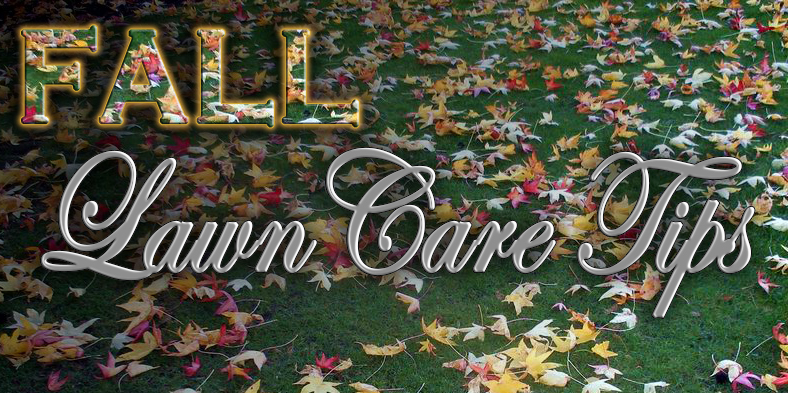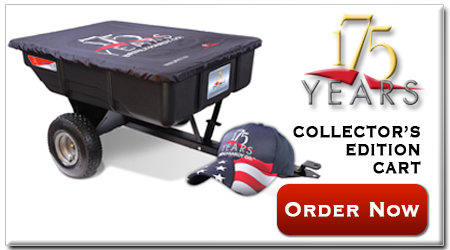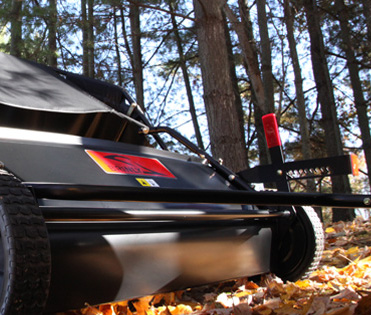
Halloween has arrived. The leaves have shed their lively green color for varying tints of yellows, oranges, and reds. As the daylight hours fade and temperatures drop, the trees and the grass prepare for the coming months of cold. Almost counter-intuitively, this time of transition is the best time of year to make headway with your lawn.
To make sure you cover all your bases, remember the mantra: Weed, Seed, and Feed. If we cover those 3 basics in the fall, we’ve laid the foundation for a thick, green, healthy lawn come springtime.
Weed
How you approach each of these 3 core areas is dependent largely upon the size of your yard. Of course, dealing with weeds is simple for those with small yards – just pull them! But if your lawn is large or you’re really losing the battle with weeds, then we might need to pull out the “chemical weapons” (also known as herbicides).
Herbicides come in liquid or granular form. Liquid herbicides generally come in a container with a built in hand-sprayer, or in concentrated form to be used with a pump sprayer or
tow-behind sprayer. Granular herbicides are applied using a
lawn spreader and can come as a standalone herbicide or as a 2-in-1 “weed and feed” combination.
Another primary distinction between herbicides is selectivity. Selective herbicides are those that can be applied to weeds without causing harm to the grass surrounding them. In contrast, non-selective herbicides are indiscriminate, killing any and all plants that they come into contact with. Non-selective weedkillers are meant for use on cracks in the driveway or areas where no vegetation is desired. Using them on the lawn, even just as a spot application, is undesirable as this will leave unsightly brown pockmarks and create areas susceptible to weed growth in springtime.
The last major difference between herbicides is the timing of the application relative to the growth cycle of the weed. If a weed control agent is applied
before the weeds are visible, it’s classified as a pre-emergent herbicide. Those that are applied to weeds that have already sprouted are classified as post-emergent herbicides. A late fall application of post-emergent herbicide followed by a springtime pre-emergent sets us up for a weed-free lawn for the upcoming year.
Seed
As turfgrasses mature, the rate at which they spread slows. This is why it is important to maintain a consistent overseeding routine in order to prevent bare spots and thinning of the lawn. The young seedlings fill in the gaps and spread more rapidly than the older grasses, helping to prevent opportunistic weeds from taking root. Overseeding can be done with varying degrees of complexity and expense, but the fundamentals are the same regardless of the method you choose.
First, remove any leaves, sticks, or other debris on the lawn. For small lawns a quick raking may suffice, but for medium or large lawns we recommend using a
tow-behind sweeper or
lawn vacuum to minimize the time and effort needed. Next, we must prepare the soil for seeding in order to maximize germination rates. The importance of removing thatch and ensuring that the soil is properly aerated cannot be understated.
Dethatching can be done easily over small areas with a simple yard rake, or you can utilize a tow-behind attachment or a standalone unit known as a power rake. If the soil is highly compacted, it will be difficult for the fragile seedlings to take root and absorb the nutrients they need to survive. There are two basic types of
aerators: spike and plug (also known as “core” aerators). Spike designs puncture the soil to allow air, water, and nutrients to be absorbed more deeply by the root system. In contrast, plug or coring aerators use a hollowed “spoon” shape to extract small cylinders of thatch and soil to create larger holes for air/water/nutrient exchange while simultaneously improving compaction throughout the lawn.
Once the lawn has been cleared, dethatched, and properly aerated, we can begin spreading. Some suggest a light topdressing first, which can further improve germination rates and improve soil drainage properties. Seed can be applied by hand, using a handheld spreader, a
push spreader, a
tow-behind spreader, or a
power seeder (also known as a slit seeder). Spreading seed by hand or using a handheld spreader is great for tight spaces and around landscaping. Large areas are best covered by a broadcast push spreader which will cover the most ground in a single pass. Power seeding units are the most costly and don’t cover as much area in a single pass as a broadcast spreader, but have the highest germination rates and can be rented from home improvement centers as needed.
Feed
Once the seed is on the ground, it will require food and water to grow. For late fall overseeding, and particularly with its cool wet conditions, starter fertilizer is recommended over standard fertilizers, which contain higher concentrations of potassium than is beneficial for seedlings. Starter fertilizers contain higher relative concentrations of nitrogen and phosphorus, yet are diluted in overall concentration to prevent burning the tender young plants.
After roughly 2 weeks of daily watering, the new seedlings should have sprouted and taken root. At this point, we may mow if needed. Any additional leaves that have fallen can be mulched to provide additional organic nutrients that will decompose over the next several months, providing optimal conditions for a thick, healthy lawn when the temperatures begin to rise again.
Want more fall lawn care tips? Comment below with your specific questions
Author:
Brad Turner

 Halloween has arrived. The leaves have shed their lively green color for varying tints of yellows, oranges, and reds. As the daylight hours fade and temperatures drop, the trees and the grass prepare for the coming months of cold. Almost counter-intuitively, this time of transition is the best time of year to make headway with your lawn. To make sure you cover all your bases, remember the mantra: Weed, Seed, and Feed. If we cover those 3 basics in the fall, we’ve laid the foundation for a thick, green, healthy lawn come springtime.
Weed
How you approach each of these 3 core areas is dependent largely upon the size of your yard. Of course, dealing with weeds is simple for those with small yards – just pull them! But if your lawn is large or you’re really losing the battle with weeds, then we might need to pull out the “chemical weapons” (also known as herbicides).
Herbicides come in liquid or granular form. Liquid herbicides generally come in a container with a built in hand-sprayer, or in concentrated form to be used with a pump sprayer or tow-behind sprayer. Granular herbicides are applied using a lawn spreader and can come as a standalone herbicide or as a 2-in-1 “weed and feed” combination.
Another primary distinction between herbicides is selectivity. Selective herbicides are those that can be applied to weeds without causing harm to the grass surrounding them. In contrast, non-selective herbicides are indiscriminate, killing any and all plants that they come into contact with. Non-selective weedkillers are meant for use on cracks in the driveway or areas where no vegetation is desired. Using them on the lawn, even just as a spot application, is undesirable as this will leave unsightly brown pockmarks and create areas susceptible to weed growth in springtime.
The last major difference between herbicides is the timing of the application relative to the growth cycle of the weed. If a weed control agent is applied before the weeds are visible, it’s classified as a pre-emergent herbicide. Those that are applied to weeds that have already sprouted are classified as post-emergent herbicides. A late fall application of post-emergent herbicide followed by a springtime pre-emergent sets us up for a weed-free lawn for the upcoming year.
Seed
As turfgrasses mature, the rate at which they spread slows. This is why it is important to maintain a consistent overseeding routine in order to prevent bare spots and thinning of the lawn. The young seedlings fill in the gaps and spread more rapidly than the older grasses, helping to prevent opportunistic weeds from taking root. Overseeding can be done with varying degrees of complexity and expense, but the fundamentals are the same regardless of the method you choose.
First, remove any leaves, sticks, or other debris on the lawn. For small lawns a quick raking may suffice, but for medium or large lawns we recommend using a tow-behind sweeper or lawn vacuum to minimize the time and effort needed. Next, we must prepare the soil for seeding in order to maximize germination rates. The importance of removing thatch and ensuring that the soil is properly aerated cannot be understated. Dethatching can be done easily over small areas with a simple yard rake, or you can utilize a tow-behind attachment or a standalone unit known as a power rake. If the soil is highly compacted, it will be difficult for the fragile seedlings to take root and absorb the nutrients they need to survive. There are two basic types of aerators: spike and plug (also known as “core” aerators). Spike designs puncture the soil to allow air, water, and nutrients to be absorbed more deeply by the root system. In contrast, plug or coring aerators use a hollowed “spoon” shape to extract small cylinders of thatch and soil to create larger holes for air/water/nutrient exchange while simultaneously improving compaction throughout the lawn.
Once the lawn has been cleared, dethatched, and properly aerated, we can begin spreading. Some suggest a light topdressing first, which can further improve germination rates and improve soil drainage properties. Seed can be applied by hand, using a handheld spreader, a push spreader, a tow-behind spreader, or a power seeder (also known as a slit seeder). Spreading seed by hand or using a handheld spreader is great for tight spaces and around landscaping. Large areas are best covered by a broadcast push spreader which will cover the most ground in a single pass. Power seeding units are the most costly and don’t cover as much area in a single pass as a broadcast spreader, but have the highest germination rates and can be rented from home improvement centers as needed.
Feed
Once the seed is on the ground, it will require food and water to grow. For late fall overseeding, and particularly with its cool wet conditions, starter fertilizer is recommended over standard fertilizers, which contain higher concentrations of potassium than is beneficial for seedlings. Starter fertilizers contain higher relative concentrations of nitrogen and phosphorus, yet are diluted in overall concentration to prevent burning the tender young plants.
After roughly 2 weeks of daily watering, the new seedlings should have sprouted and taken root. At this point, we may mow if needed. Any additional leaves that have fallen can be mulched to provide additional organic nutrients that will decompose over the next several months, providing optimal conditions for a thick, healthy lawn when the temperatures begin to rise again.
Want more fall lawn care tips? Comment below with your specific questions
Author: Brad Turner
Halloween has arrived. The leaves have shed their lively green color for varying tints of yellows, oranges, and reds. As the daylight hours fade and temperatures drop, the trees and the grass prepare for the coming months of cold. Almost counter-intuitively, this time of transition is the best time of year to make headway with your lawn. To make sure you cover all your bases, remember the mantra: Weed, Seed, and Feed. If we cover those 3 basics in the fall, we’ve laid the foundation for a thick, green, healthy lawn come springtime.
Weed
How you approach each of these 3 core areas is dependent largely upon the size of your yard. Of course, dealing with weeds is simple for those with small yards – just pull them! But if your lawn is large or you’re really losing the battle with weeds, then we might need to pull out the “chemical weapons” (also known as herbicides).
Herbicides come in liquid or granular form. Liquid herbicides generally come in a container with a built in hand-sprayer, or in concentrated form to be used with a pump sprayer or tow-behind sprayer. Granular herbicides are applied using a lawn spreader and can come as a standalone herbicide or as a 2-in-1 “weed and feed” combination.
Another primary distinction between herbicides is selectivity. Selective herbicides are those that can be applied to weeds without causing harm to the grass surrounding them. In contrast, non-selective herbicides are indiscriminate, killing any and all plants that they come into contact with. Non-selective weedkillers are meant for use on cracks in the driveway or areas where no vegetation is desired. Using them on the lawn, even just as a spot application, is undesirable as this will leave unsightly brown pockmarks and create areas susceptible to weed growth in springtime.
The last major difference between herbicides is the timing of the application relative to the growth cycle of the weed. If a weed control agent is applied before the weeds are visible, it’s classified as a pre-emergent herbicide. Those that are applied to weeds that have already sprouted are classified as post-emergent herbicides. A late fall application of post-emergent herbicide followed by a springtime pre-emergent sets us up for a weed-free lawn for the upcoming year.
Seed
As turfgrasses mature, the rate at which they spread slows. This is why it is important to maintain a consistent overseeding routine in order to prevent bare spots and thinning of the lawn. The young seedlings fill in the gaps and spread more rapidly than the older grasses, helping to prevent opportunistic weeds from taking root. Overseeding can be done with varying degrees of complexity and expense, but the fundamentals are the same regardless of the method you choose.
First, remove any leaves, sticks, or other debris on the lawn. For small lawns a quick raking may suffice, but for medium or large lawns we recommend using a tow-behind sweeper or lawn vacuum to minimize the time and effort needed. Next, we must prepare the soil for seeding in order to maximize germination rates. The importance of removing thatch and ensuring that the soil is properly aerated cannot be understated. Dethatching can be done easily over small areas with a simple yard rake, or you can utilize a tow-behind attachment or a standalone unit known as a power rake. If the soil is highly compacted, it will be difficult for the fragile seedlings to take root and absorb the nutrients they need to survive. There are two basic types of aerators: spike and plug (also known as “core” aerators). Spike designs puncture the soil to allow air, water, and nutrients to be absorbed more deeply by the root system. In contrast, plug or coring aerators use a hollowed “spoon” shape to extract small cylinders of thatch and soil to create larger holes for air/water/nutrient exchange while simultaneously improving compaction throughout the lawn.
Once the lawn has been cleared, dethatched, and properly aerated, we can begin spreading. Some suggest a light topdressing first, which can further improve germination rates and improve soil drainage properties. Seed can be applied by hand, using a handheld spreader, a push spreader, a tow-behind spreader, or a power seeder (also known as a slit seeder). Spreading seed by hand or using a handheld spreader is great for tight spaces and around landscaping. Large areas are best covered by a broadcast push spreader which will cover the most ground in a single pass. Power seeding units are the most costly and don’t cover as much area in a single pass as a broadcast spreader, but have the highest germination rates and can be rented from home improvement centers as needed.
Feed
Once the seed is on the ground, it will require food and water to grow. For late fall overseeding, and particularly with its cool wet conditions, starter fertilizer is recommended over standard fertilizers, which contain higher concentrations of potassium than is beneficial for seedlings. Starter fertilizers contain higher relative concentrations of nitrogen and phosphorus, yet are diluted in overall concentration to prevent burning the tender young plants.
After roughly 2 weeks of daily watering, the new seedlings should have sprouted and taken root. At this point, we may mow if needed. Any additional leaves that have fallen can be mulched to provide additional organic nutrients that will decompose over the next several months, providing optimal conditions for a thick, healthy lawn when the temperatures begin to rise again.
Want more fall lawn care tips? Comment below with your specific questions
Author: Brad Turner



